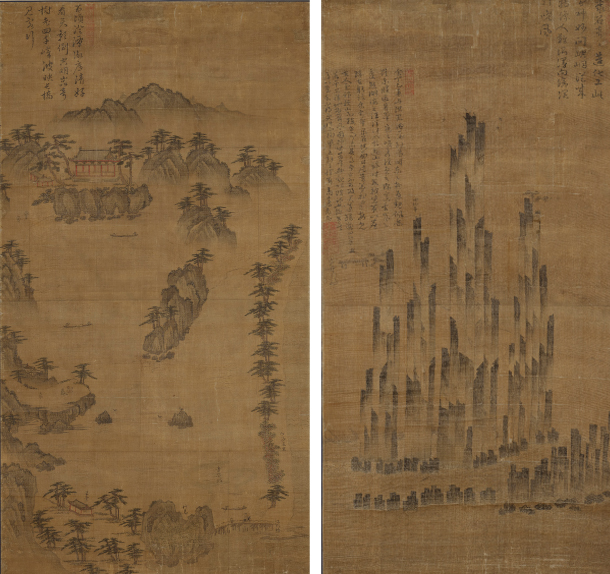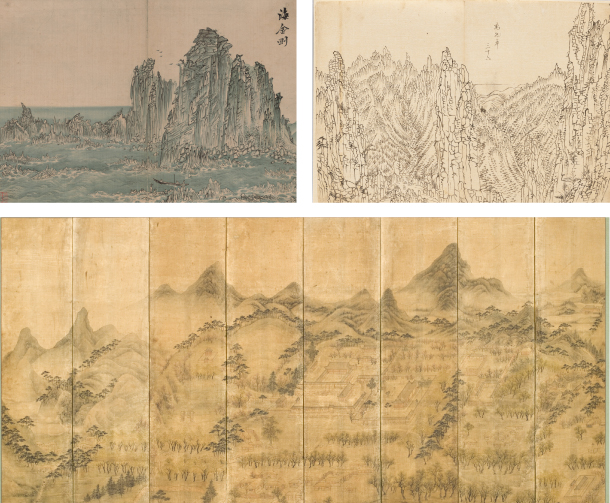Looking at the many sides of Korea’s natural landscape: Exhibit highlights work of Joseon artists tasked with painting nature

Left: A painting of “Gyeongpodae Pavilion” by an unknown artist from the 16th century. Right: A painting of “Chongseokjeong Pavilion” by an unknown artist was recently donated to the National Museum of Korea from Japan, along with the “Gyeongpodae Pavilion.”[NATIONAL MUSEUM OF KOREA]
Many Koreans began taking summer vacations recently and while some are heading to foreign countries, Bae Ki-dong, director general of the National Museum of Korea, encourages people to explore their own country because “there are so many naturally beautiful spots in Korea.”
“Maybe this summer, Koreans can turn their eyes to some of the beautiful spots in Korea by taking a look at the Korean landscape through the eyes of the Joseon painters,” Bae said.
A special exhibition titled “Through the Eyes of Joseon Painters: Real Scenery Landscapes of Korea” kicked off at the museum in Yongsan District, central Seoul today. It displays about 360 landscape paintings of Korean mountains and rivers that reveal “some of the hidden beauties of Korea,” according to the museum.
Of course some paintings are of scenic spots like Mount Kumgang, located in North Korea, where South Koreans cannot visit. But Bae insists visitors take an actual trip to the places depicted in the paintings after enjoying the exhibition.
“We’ve included a map in the brochure to help visitors learn where the spots are,” he added.
There’s been numerous landscape painting exhibitions in Korea, but according to Bae, this exhibit is “unlike any other,” as there are many paintings being shown to the public for the first time.

Top left: Kim Ha-jong’s “Haegeum River” included in the “Album of Sea and Mountains” (1816). Top right: Kim Hong-do’s “Manmulcho” included in the “Album of Famous Mountains in Korea” (1788). Above: Lee Han-Cheol’s “Seokpajeong Pavilion” (1860) is being exhibited in Korea for the first time. It’s an eight-panel folding screen. [NATIONAL MUSEUM OF KOREA]
“It is the oldest existing landscape painting of Gangwon and the technique that the painter used, according to experts, will help a lot in the research of landscape paintings of the Joseon Dynasty,” said Bae.
Ahn Hwui-jun, a veteran art historian in Korea also said that “these two paintings prove that traditions of scenery landscape painting were well-established before renowned Korean landscape painter Jeong Seon (1676-1759).”
The exhibit is divided in four sections and these two paintings can be viewed in the beginning of the exhibition, in the “Paining Landscapes as They Are” section.
In the second “Sketching on the Spot” section, visitors can view the first sketches of many painters. Although they are rough drafts, they still look like final copies.
“Traveling to famous scenic sites was not easy in the past,” said Oh Da-yeon, one of the curators of the exhibition. “It was costly and difficult for Joseon court painters to take time away from their daily tasks. Therefore, they quickly sketched the landscapes on the paper and completed the painting after returning home.”
The next section, “Adapting the Actual Scene,” shows how the sketches were turned into paintings. According to Oh, there were three traditional viewpoints widely used by Joseon painters: High Distance, which is a view from the bottom of a mountain to its peak; Level Distance, which is a view from a near mountain to a far mountain; and Deep Distance, which is from the front of a mountain to its back. Using different viewpoints, similar scenic points were expressed in different forms, such as folding fans, folding screens, frames and so on.
The final “Transcending Real Scenery Landscapes” section displays experimental works of the Joseon painters, who endeavored to “express their own ideas and individualities by reinterpreting scenery, experimenting with it and thus transcending it.”
Some of the works here are exaggerated, painted using fingers instead of brushes, and used unique colors.
The exhibition runs until Sept. 22. Tickets cost 5,000 won ($4.25).
BY YIM SEUNG-HYE [sharon@joongang.co.kr]










with the Korea JoongAng Daily
To write comments, please log in to one of the accounts.
Standards Board Policy (0/250자)